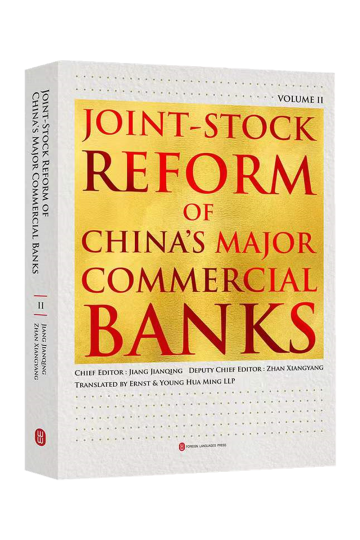The Joint-Stock Reform of China’s Major Commercial Banks is dedicated to the 40th anniversary of China’s reform and opening up. This book is divided into two volumes. Volume I, comprising ten chapters –“Introduction,” “Epilogue” and eight others – is a historical recount of the jointstock reform. The first three chapters treat the 30 years of reforms of state-owned banks as a cohesive effort heralding the joint-stock reform itself. Chapter 4 covers the discussion, formulation, and introduction of the reform plan following the decision at the Second National Financial Work Conference, to launch the reform as a pilot program, giving both a detailed account and a behind-the-scene look at the development of the top-level designs. Chapters 5 and 6 recall the full implementation of the reform, from its pilot stage at BOC and CCB, to its intensification and expansion at BoCom and ICBC, and lastly to its conclusion at ABC. While noting the four-step process common to the jointstock reform of these banks – financial restructuring, creation of a joint-stock company, introduction of strategic investors, and public listing-attention was also given to the differences. Chapter 7 summarizes the effort and progress made by the Big Five in corporate governance, risk management, and internal controls following the joint-stock reform. Chapter 8 explicates the eight chief effects of the reform and contains a quantitative cost-benefit analysis which shows, with real data, that the post-reform benefits have outweighed the costs borne by the state, and that the reform has breathed new life into the banks. Lastly, in “Epilogue” we sum up the lessons from the reform and voice some general issues and expectations that may help shape further and more extensive changes for China’s major commercial banks. Volume II of the Joint-Stock Reform of China’s Major Commercial Banks is a collection of transcripts from tape-recorded interviews of 21 people who once led, organized, and witnessed the joint-stock reform of state-owned banks.
Joint-Stock Reform of China's Major Commercial Banks VolumeⅡ(English edition)
- Author Jiang Jianqing
- Book NO. 12903
- Words 300thousand
- Pages 460
- Price 168
- Edition 1-1
- ISBN 978-7-119-12903-7
- Format 16
- Publish Year 2021
- Language English


